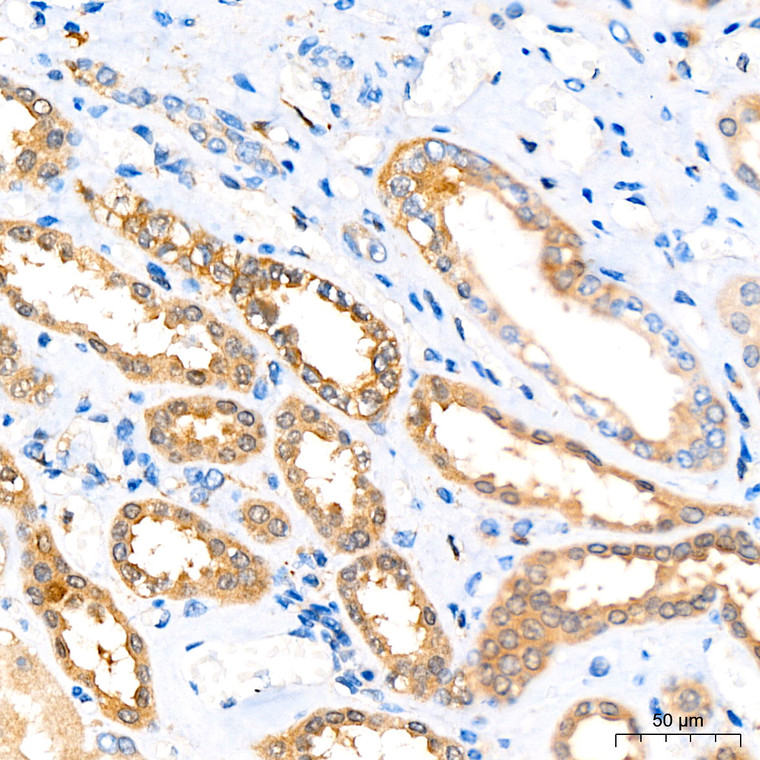| Host: |
Rabbit |
| Applications: |
WB/IHC |
| Reactivity: |
Human/Mouse/Rat |
| Note: |
STRICTLY FOR FURTHER SCIENTIFIC RESEARCH USE ONLY (RUO). MUST NOT TO BE USED IN DIAGNOSTIC OR THERAPEUTIC APPLICATIONS. |
| Short Description: |
Rabbit monoclonal antibody anti-ATG3 (1-100) is suitable for use in Western Blot and Immunohistochemistry research applications. |
| Clonality: |
Monoclonal |
| Clone ID: |
S8MR |
| Conjugation: |
Unconjugated |
| Isotype: |
IgG |
| Formulation: |
PBS with 0.02% Sodium Azide, 0.05% BSA, 50% Glycerol, pH7.3. |
| Purification: |
Affinity purification |
| Dilution Range: |
WB 1:500-1:1000IHC-P 1:50-1:200 |
| Storage Instruction: |
Store at-20°C for up to 1 year from the date of receipt, and avoid repeat freeze-thaw cycles. |
| Gene Symbol: |
ATG3 |
| Gene ID: |
64422 |
| Uniprot ID: |
ATG3_HUMAN |
| Immunogen Region: |
1-100 |
| Immunogen: |
A synthetic peptide corresponding to a sequence within amino acids 1-100 of human Apg3 (Atg3) (Q9NT62). |
| Immunogen Sequence: |
MQNVINTVKGKALEVAEYLT PVLKESKFKETGVITPEEFV AAGDHLVHHCPTWQWATGEE LKVKAYLPTGKQFLVTKNVP CYKRCKQMEYSDELEAIIEE |
| Tissue Specificity | Widely expressed, with a highest expression in heart, skeletal muscle, kidney, liver and placenta. |
| Post Translational Modifications | Conjugated to ATG12 at Lys-243. ATG12-conjugation plays a role in regulation of mitochondrial homeostasis and cell death, while it is not involved in PE-conjugation to ATG8-like proteins and autophagy. Cleaved by CASP8 upon death ligand binding such as tumor necrosis factor-alpha. CASP8 cleavage blocks survival-related autophagy and favors apoptosis. |
| Function | E2 conjugating enzyme required for the cytoplasm to vacuole transport (Cvt), autophagy, and mitochondrial homeostasis. Responsible for the E2-like covalent binding of phosphatidylethanolamine to the C-terminal Gly of ATG8-like proteins (GABARAP, GABARAPL1, GABARAPL2 or MAP1LC3A). The ATG12-ATG5 conjugate plays a role of an E3 and promotes the transfer of ATG8-like proteins from ATG3 to phosphatidylethanolamine (PE). This step is required for the membrane association of ATG8-like proteins. The formation of the ATG8-phosphatidylethanolamine conjugates is essential for autophagy and for the cytoplasm to vacuole transport (Cvt). Preferred substrate is MAP1LC3A. Also acts as an autocatalytic E2-like enzyme, catalyzing the conjugation of ATG12 to itself, ATG12 conjugation to ATG3 playing a role in mitochondrial homeostasis but not in autophagy. ATG7 (E1-like enzyme) facilitates this reaction by forming an E1-E2 complex with ATG3. Promotes primary ciliogenesis by removing OFD1 from centriolar satellites via the autophagic pathway. |
| Protein Name | Ubiquitin-Like-Conjugating Enzyme Atg3Autophagy-Related Protein 3Apg3-LikeHapg3Protein Pc3-96 |
| Database Links | Reactome: R-HSA-1632852 |
| Cellular Localisation | Cytoplasm |
| Alternative Antibody Names | Anti-Ubiquitin-Like-Conjugating Enzyme Atg3 antibodyAnti-Autophagy-Related Protein 3 antibodyAnti-Apg3-Like antibodyAnti-Hapg3 antibodyAnti-Protein Pc3-96 antibodyAnti-ATG3 antibodyAnti-APG3 antibodyAnti-APG3L antibody |
Information sourced from Uniprot.org
12 months for antibodies. 6 months for ELISA Kits. Please see website T&Cs for further guidance











![Immunoprecipitation analysis of 600 Mu g extracts of 293T cells using 3 Mu g [KD Validated] CDX2 Rabbit monoclonal antibody (STJ11101568). Western blot was performed from the immunoprecipitate using CDX2 antibody (STJ11101568) at a dilution of 1:500. Immunoprecipitation analysis of 600 Mu g extracts of 293T cells using 3 Mu g [KD Validated] CDX2 Rabbit monoclonal antibody (STJ11101568). Western blot was performed from the immunoprecipitate using CDX2 antibody (STJ11101568) at a dilution of 1:500.](https://cdn11.bigcommerce.com/s-zso2xnchw9/images/stencil/300x300/products/90481/359933/STJ11101568_1__84936.1713124490.jpg?c=1)


